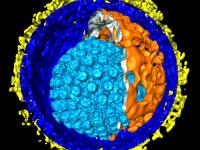
This is a detailed 3D-structure of the herpes virus: the capsid or protein shell, which contains the virus DNA, is surrounded by several envelope layers. The genome encodes the complete information needed by an organism, including that required for protein production. Viruses, which are up to a thousand times smaller than human cells, have considerably smaller genomes. Using a type of herpesvirus as a model system, the scientists of the Max Planck Institute of Biochemistry in Martinsried near Munich and their collaboration partners at the University of California in San Francisco have shown that the genome of this virus contains much more information than previously assumed. The researchers identified several hundred novel proteins, many of which were surprisingly small.
More than 80 percent of the world's population is infected with the herpesvirus, which can cause severe diseases in newborns and in persons with weakened immune system. Researchers had already sequenced the herpesvirus genome 20 years ago, thinking they could then predict all proteins that the virus produces (virus proteome). Now scientists from the research department of Matthias Mann, director at the Max Planck Institute of Biochemistry, and their American colleagues have analysed the information content of the genome more precisely.
To carry out their study, the scientists infected cells with herpesvirus and observed which proteins the virus produced inside the cell over a period of 72 hours. In order for proteins to be produced at all, the cell machinery must first make copies of the genetic material as intermediate products (RNA). While investigating the intermediate products of the herpesvirus, the American collaborators discovered many novel RNA molecules which were in large part surprisingly short. They also found that the organization of information required for protein production in the virus genome was far more complex than previously assumed. Annette Michalski, a scientist in the Department of Proteomics and Signal Transduction at the Max Planck Institute of Biochemistry, was subsequently able to confirm directly the predicted viral proteins in the infected cell using mass spectrometry. This method enables an overview of the complete proteome of the virus-infected cell.
The results of the American and German researchers provide detailed insight into the complex mechanisms used by the virus. "We showed that it's not enough merely to know the virus genome to understand the biology of the herpesvirus," Annette Michalski said. "What is important is to look at the products actually produced from the genome." Even human genes may be much more complex than the genome sequence itself indicates, commented the researchers. Matthias Mann and his colleagues plan to investigate this question further in the coming years.
Source : Max-Planck-Gesellschaft
 Print Article
Print Article Mail to a Friend
Mail to a Friend
